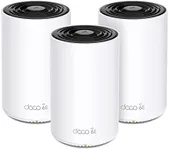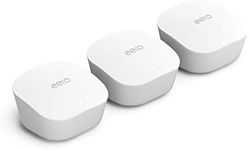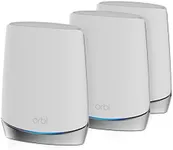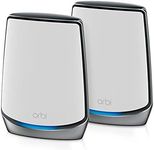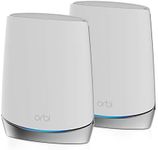Buying Guide for the Best Mesh Wi Fi Systems
Choosing a mesh Wi-Fi system can greatly improve your home internet experience, especially if you have a large house or areas where your current Wi-Fi signal is weak. Mesh systems use multiple devices (called nodes or satellites) that work together to spread Wi-Fi coverage more evenly throughout your space. When picking the right mesh Wi-Fi system, it's important to understand the key features and how they relate to your needs, such as the size of your home, the number of devices you use, and the types of activities you do online.Coverage AreaCoverage area refers to the total space that the mesh Wi-Fi system can effectively cover with a strong signal. This is usually measured in square feet or meters. It's important because you want to make sure your entire home, including hard-to-reach spots like basements or upstairs rooms, gets reliable Wi-Fi. Systems are often divided into small (up to 2,000 sq ft), medium (2,000–4,000 sq ft), and large (over 4,000 sq ft) coverage. To pick the right one, consider the size and layout of your home, and remember that walls and floors can reduce coverage, so it's better to choose a system that covers a bit more than you think you need.
Number of NodesThe number of nodes is how many separate devices come with the system. More nodes mean you can spread them out to cover more space or tricky areas. Basic kits usually have two or three nodes, but you can often add more if needed. If you have a small apartment, two nodes might be enough, but for multi-story homes or places with lots of walls, three or more nodes can help eliminate dead zones. Think about where you need the strongest signal and choose a system that lets you place nodes in those spots.
Wi-Fi Standard (e.g., Wi-Fi 5, Wi-Fi 6)The Wi-Fi standard tells you what generation of wireless technology the system uses. Newer standards like Wi-Fi 6 offer faster speeds, better performance with many devices, and improved efficiency. Wi-Fi 5 is still common and works well for most homes, but Wi-Fi 6 is better if you have lots of smart devices or do things like gaming and streaming in 4K. If your devices support Wi-Fi 6, it's a good idea to choose a mesh system with this standard for future-proofing.
Maximum SpeedMaximum speed is the highest data rate the system can handle, usually shown in Mbps or Gbps. This matters if you have a fast internet plan or do activities that need a lot of bandwidth, like streaming high-definition videos or online gaming. Mesh systems are often grouped into basic (up to 500 Mbps), mid-range (500–1,200 Mbps), and high-end (over 1,200 Mbps) speeds. To pick the right one, match the system's speed to your internet plan and your usage habits—there's no need to pay for more speed than your internet provider gives you.
Ethernet PortsEthernet ports let you connect devices directly to the mesh node with a cable for a more stable and faster connection. This is useful for things like gaming consoles, desktop computers, or smart TVs. Some mesh systems have only one or two ports per node, while others have several. If you have devices that need a wired connection, look for a system with enough ports, or consider using a separate Ethernet switch.
Ease of Setup and ManagementEase of setup and management refers to how simple it is to get your mesh system running and to control it afterward. Many systems offer smartphone apps that guide you through installation and let you manage settings, check device connections, or set up parental controls. If you're not very tech-savvy, look for a system known for its user-friendly app and clear instructions. This will make it easier to troubleshoot and keep your network running smoothly.
Parental Controls and Security FeaturesParental controls and security features help you manage what devices can access and protect your network from threats. Some systems let you set time limits, block certain websites, or pause the internet for specific users. Security features might include automatic updates, malware protection, or guest networks. If you have children or want extra peace of mind, choose a system with strong, easy-to-use controls and security options.



